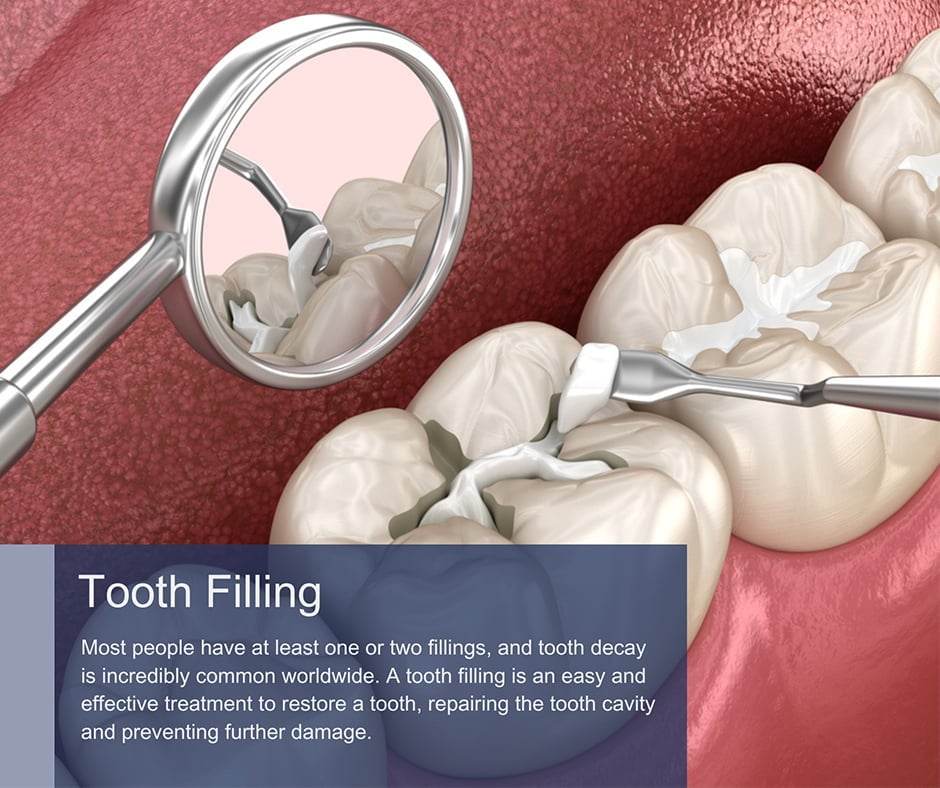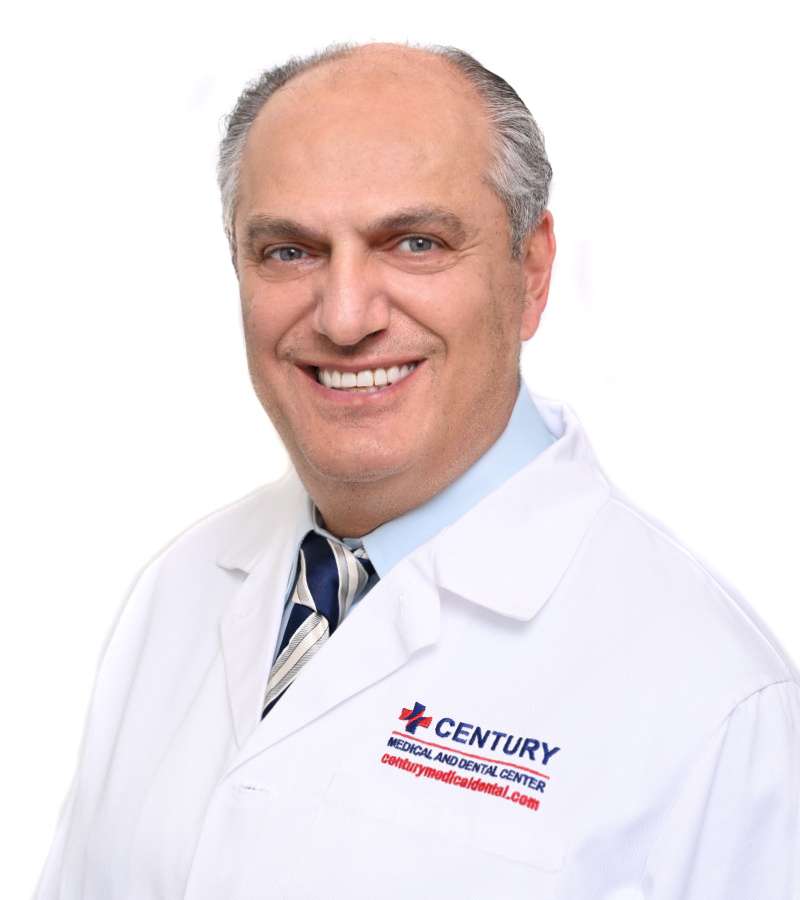Table of contents
Most people have at least one or two fillings, and tooth decay is incredibly common worldwide. A tooth filling is an easy and effective treatment to restore a tooth, repairing the tooth cavity and preventing further damage. Dental fillings are also used to repair teeth that may have become damaged due to trauma, replacing the missing tooth structure and restoring strength and appearance.
The most common cause of a cavity in a tooth is tooth decay, where the outer layer of protective tooth enamel has become damaged. The damage can occur because of acid erosion, where acids are produced by harmful bacteria found in dental plaque. These bacteria produce acid as they feast on leftover food particles, and the acids weaken and erode tooth enamel. Eventually, this results in a hole or opening that allows bacteria to penetrate the inner part of the tooth.
Directly underneath the enamel is a layer of dentin that is much softer and more easily eroded by these bacteria. Sometimes a small hole in a tooth can mask a much larger cavity underneath; the tooth can crumble away when you bite down unless the cavity is filled promptly. Other times, a tooth can become damaged if it takes a knock or blow, resulting in it becoming chipped or cracked so harmful bacteria can easily penetrate the exposed dentin. It is important to mend any damage to the tooth enamel, regardless of cause, as soon as possible.
Leaving an untreated cavity or a crack or chip in a tooth increases the risk of the tooth becoming severely infected in the future, at which stage it can become extremely painful. A severe tooth infection may require root canal therapy, or, in the worst case, removing the tooth may be necessary, a situation we would far rather avoid.

The most common sign is increased tooth sensitivity, so when you eat or drink anything hot or cold or something very sweet or sour, the tooth may twinge or even feel painful. Breathing in through your mouth on a cold winter’s day can have this same effect. Sometimes it’s possible to see a hole in a tooth as a dark spot. If you have a chip or crack in a tooth, you might feel the sharp edge with your tongue, or sometimes it’s very easy to spot if it is right in your smile line.
When you visit Century Dental for your checkup, we assess every tooth closely, looking for signs of any lesions or holes in teeth, sometimes detecting them before you know anything is wrong. The sooner we can detect signs of tooth decay or damage to a tooth, the more easily we can restore it as the filling is likely smaller, less invasive to place, and cheaper to complete. Sometimes, if a tooth only has a tiny lesion, we might be able to treat it with professional-strength fluoride applications to re-harden the enamel.
First off i want to give a shout out to the dental assistant i had. I don't think i caught her name but she was the sweetest most engaging person and our conversation was so natural and casual like she was an old friend which made my very first visit (Today) to this office such a great experience. Of course my dentist Ethan was exceptional and very helpful as well but today's cherry and 5 star earner was her ❤️.
A dental filling can be made from a variety of high-quality materials, depending on the location of the tooth, the size of the cavity, and your preference. Materials commonly used to mend teeth include amalgam, composite resin, glass ionomer, porcelain, and gold.
Amalgam fillings are a silver-colored alloy made from several different metals, including mercury. The material has been used for many decades and is durable, hard-wearing, and cost-effective but highly visible. Over time the amalgam can discolor, and it flexes when it comes into contact with hot and cold. Over time, continual flexing can eventually create microfractures in teeth that weaken the overall structure. While amalgam is still widely used, it has largely been replaced with other more advanced and modern materials, particularly composite resin.
Composite resin fillings are sometimes called white fillings because the material looks exactly like a real tooth. The advantage of a composite resin filling is that it is biocompatible, working harmoniously with your tooth structure. It doesn’t flex when it comes under pressure or in contact with hot or cold, and most importantly, it is tooth-colored.
We keep a wide range of colors of composite resin in stock. Our skilled cosmetic dentists can closely match the color of your composite resin filling to your natural tooth, resulting in a virtually invisible filling. We recommend using composite resin if you need a front tooth cavity filling.
Composite resin is durable, hard-wearing, and ideal for small to medium-sized cavities and restoring a front tooth filling. A composite resin filling should last several years before it needs replacing, but it can start to look stained if you have lifestyle habits like smoking or consuming many highly colored foods and drinks. If you have a larger cavity, for example, on the chewing surface of one of your back teeth, you may need a filling made from gold or porcelain.
Glass ionomer fillings are used to fill cavities below the gumline and which affect the tooth roots. They are made from glass and acrylic and release fluoride that can help protect the tooth from further decay. These fillings tend to be weaker than composite resin but should last several years or more before they need replacing.
Gold alloy is a good filling material for repairing larger cavities in back teeth as the gold will not damage or wear down your opposing teeth. It is also strong and hard-wearing and can last for many years. However, gold is quite visible, and gold fillings can be expensive depending on the market price. A gold filling is called an inlay or onlay.
Modern porcelains are easily strong enough to repair large cavities affecting the chewing surfaces of your back teeth, restoring these teeth invisibly. Porcelain is ideal if you prefer a more cosmetic filling than gold and can last many years. A porcelain filling is called an inlay or onlay.

Family Dentist
Brooklyn
Gravesend

Family Dentist
Manhattan
Manhattan

Family Dentist
Brooklyn & Manhattan
Manhattan, Downtown

Dentist
Brooklyn & Manhattan
Gravesend, Manhattan, Downtown

Dentist
Manhattan
Manhattan

Dentist
Brooklyn & Manhattan
Manhattan, Livingston

Dentist
Brooklyn & Manhattan
Manhattan, Livingston
An ordinary filling is made inside the mouth, so our dentist can prepare the tooth and place the filling in a single appointment. An inlay or onlay is an indirect filling, so it is made outside of the mouth. An inlay can repair a large cavity in the chewing surface of a back tooth, while an onlay is slightly larger. An onlay can repair the chewing surface as well is one or more of the tooth cusps. The cusps are the pointed parts of the tooth on the inner and outer edges.
It’s necessary to use an inlay or onlay when a cavity is larger because these restorations are stronger and more durable, whereas an ordinary filling wouldn’t provide adequate strength.
Before beginning a tooth filling, we may take a dental x-ray to check the extent of the decay and plan your treatment. The process is very straightforward and shouldn’t feel painful. First, our dentist will numb the tooth before removing any dental decay and prepare the cavity for filling, shaping, and cleaning it thoroughly.
Once the cavity is prepared, the tooth is dried, and the filling can be placed. The filling material is placed in small increments and, in the case of composite resin, is hardened using a special light. Once all the material is in place, we carefully shape the filling and polish it to resemble the size and shape of a real tooth. Lastly, we check your bite to ensure you can bite comfortably on the tooth.
If you need an inlay or onlay, we prepare the tooth before taking a detailed dental impression. The inlay or onlay can be crafted in the dental lab to our exact specifications and, once ready, permanently cemented into the tooth. In the meantime, until the restoration is ready, we place a temporary filling to protect the tooth.
Once the local anesthetic wears off, your tooth should feel comfortable for everyday activities, including biting and chewing food. It’s perfectly normal for a tooth to feel slightly sensitive to temperature changes or sweet foods after it is first placed. Usually, this sensitivity should disappear within a few weeks. Please contact us if the sensitivity remains so we can check the tooth. Sometimes it’s necessary to adjust a filling that may interfere with your bite, and the adjustment is easy and quick to complete.
A tooth filling is a routine restorative treatment that protects and preserves your natural tooth, preventing further decay and infection. If you think you have a cavity or have damaged a tooth, please come and see us quickly before the damage can worsen and cause unpleasant symptoms.
Century Medical and Dental Center is an accredited healthcare facility in NY that operates in accordance with Article 28, a public health law. This law regulates and recognizes accreditation for public healthcare facilities, ensuring they are licensed and operated correctly. By undergoing the Article 28 process and achieving accreditation, Century Medical and Dental Center demonstrates its commitment to meeting the highest standards of care.
As a multidisciplinary medical center, we have highly qualified doctors, nurses, and support staff who are working hard to provide the best medical care to patients in Midtown Manhattan, NY, Downtown Brooklyn, NY, including Brooklyn Heights, Dumbo, Prospect Heights, Park Slope, Clinton Hill, Boerum Hill, Red Hook, and Bedford-Stuyvesant.